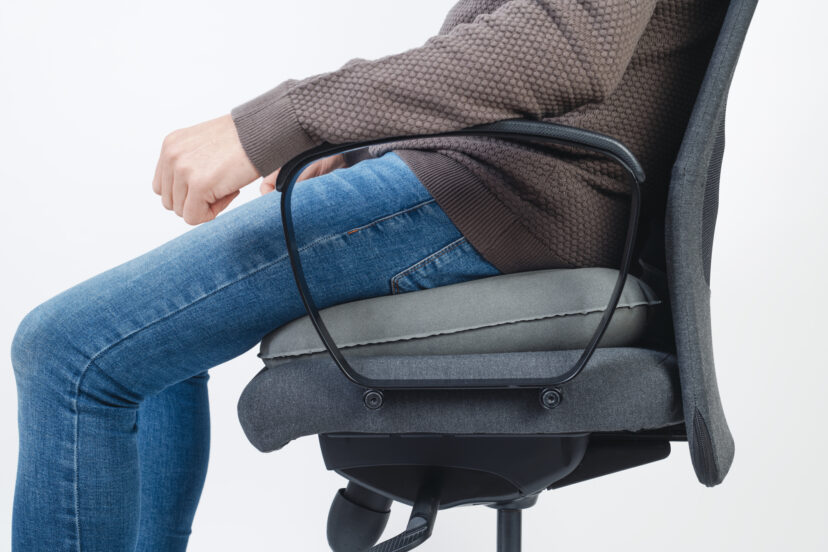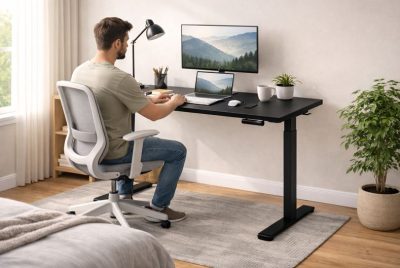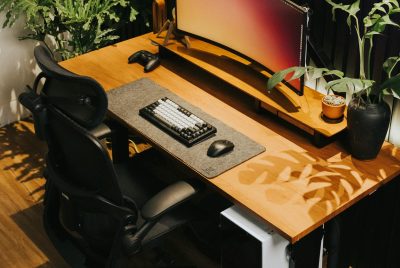Ergonomic Seat Cushion: Guide to Comfort and Posture
We may earn a commission for purchases made using our links. Please see our disclosure to learn more.
Sitting for hours can give you body aches, lower back pains, and even poor posture. That is why finding the right cushion that supports your body (like it should) is a must. An ergonomic seat cushion could be your best bud! Whether you’re sitting at a desk or driving for long hours, this cushion offers comfort. Let’s dig deeper and learn why this is the one thing you never knew you needed before!
What is an Ergonomic Seat Cushion?
Think of an ergonomic seat cushion as a specialized sidekick, designed to cater to the natural curves of your spine. Unlike any ordinary cushion, it’s crafted to reduce pressure on your lower back, hips, and tailbone. These aren’t just cushions—they’re engineered with unique materials and thoughtful shapes to help you sit the way your body was meant to.
Why Choose an Ergonomic Seat Cushion?
An ergonomic seat cushion is basically an extra pillow or cushion you put on any seat for extra comfort. It can be placed on office chairs, car seats, and even wheelchairs. The best thing I like about these ergo cushions is that they help ease the stress of sitting for hours. They are usually made from gel or memory foam. Imagine going on a long drive without walking away with an achy back. What a relief! That’s their job, making sure you’re feeling supported and comfortable as much as possible.

How Do Ergonomic Cushions Work?
So, how do these ergonomic seat cushions work wonders? Alright, here’s the thing. Imagine a firm foam gently lifting your spine and hips where it should be. This cushion balances the weight across your seat. They relieve pressure points and encourage you to sit properly. Let’s say I’ve been sitting for a few hours, this cushion helps alleviate tailbone pressure so I don’t feel like someone punched my back and bottom right after. It also helps in blood circulation, folks!
Types of Ergonomic Seat Cushions
The variety of ergonomic cushions is impressive, each one with a little twist to meet different needs. Here are some of the main types:
- Memory Foam Cushions – Think of these as the “hug” option, molding to your body and offering soft yet solid support.
- Gel Cushions – For those who like things cool, gel cushions prevent overheating while providing great support.
- Inflatable Cushions – Light and adjustable, these let you customize the firmness to your taste.
- Wedge Cushions – These elevate your pelvis, encouraging a natural tilt and better posture.
- Donut Cushions – Especially helpful for tailbone pain, they reduce direct pressure on sensitive areas.
What Materials are Used in Ergonomic Seat Cushions?
The magic of an ergonomic cushion is all in the materials. Here are some common ones and their roles:
- Memory Foam: Conforms to your body, relieving pressure.
- Gel: Keeps you cool, wicking away sweat.
- High-Density Foam: Offers firm support that holds up over time.
Why is Memory Foam So Popular?
Memory foam is so popular mainly because it is comfortable and durable at the same time. It’s like a favorite sweater—soft, adaptable, and reliable. It supports and cradles your lower body, responding to your shape and easing tension without going flat after a while. Personally, I prefer memory foam cushions because they give a different level of comfort and are super easy to clean!
How to Pick the Right Size?
When it comes to ergonomic seat cushions, size is a big deal. Of course, we are built differently. Some have big body frames, and some are a bit smaller. Recently, I bought a smaller size cushion (well, I made a mistake on the size) and it really makes no difference. And it felt awkward too!!! So, make sure to check the measurements to ensure it fits your chair and suits your body. Save yourself from the hassle of returning products, just like what happened to me lol.
Benefits of Using an Ergonomic Seat Cushion
A good ergonomic cushion does more than keep you comfy; it has the power to impact your health. Here’s how:
- Reduces Lower Back Pain: By supporting the natural lumbar curve, it can relieve or even prevent back pain.
- Improves Posture: Promoting proper posture isn’t just good for your back; it also helps keep you comfortable longer.
- Boosts Productivity: When you’re sitting comfortably, focus and productivity can flourish.
- Aids Blood Circulation: By relieving pressure, ergonomic cushions encourage better blood flow.
The Role of Cushion Material and Biomechanics in Seating Comfort
Research on slow-recovery foam cushions reveals their superior pressure distribution and comfort compared to fast-recovery foams, providing significant relief during prolonged sitting (Frontiers in Bioengineering). Similarly, biomechanics in ergonomic furniture design highlights the importance of understanding human anatomy and optimizing pressure points to prevent discomfort and musculoskeletal issues (MDPI Applied Sciences). These insights contribute to the effective design of ergonomic seat cushions that promote healthy posture and reduce fatigue.
Top Recommended Ergonomic Seat Cushions for Ultimate Comfort
- Everlasting Comfort Memory Foam Seat Cushion
- High-quality memory foam
- Ideal for office chairs, cars, and home use
- Contoured design for tailbone support
- ComfiLife Gel Enhanced Seat Cushion
- Combines memory foam and gel for cooling support
- Non-slip bottom for stability
- Great for long periods of sitting
- Purple Royal Seat Cushion
- Unique grid design for pressure relief
- Breathable material to keep cool
- Works well for those with tailbone pain
- TushGuard Ergonomic Seat Cushion
- Orthopedic support for tailbone and lower back
- Lightweight and portable
- Recommended for sciatica relief
- Fortem Seat Cushion & Lumbar Support Set
- Includes lumbar support pillow for full back support
- Premium memory foam with washable covers
- Great value for comprehensive ergonomic support
Who Should Use an Ergonomic Seat Cushion?
Anyone, as in anyone! But it’s definitely a game changer to those who sit for long periods or folks dealing with a back pain. Believe me or not, but a good cushion could bring real relief. Sure, you can add a regular pillow at your bottom while sitting in an office chair or driving. But they’re “too soft” and it will feel like you aren’t getting any comfort after a few hours in it.
How to Use an Ergonomic Seat Cushion Properly
Don’t think that this is nonsense but actually, placement also matters. Why? An ergonomic seat cushion has curves so you should properly place it on your seat. Place the thicker part at the back of your chair (not the other way around). This aligns with your natural spinal curve, letting the cushion do its job.
Caring for Your Ergonomic Seat Cushion
An ergonomic seat cushion is durable and it can last long. But, even the best cushions need a bit of TLC. Most come with removable covers you can toss in the wash. Regular cleaning helps keep it fresh, extending the life of your cushion.
Portable Ergonomic Cushions for On-the-Go Comfort
Want to take your ergo cushions anywhere, anytime? Sure! For those who are always on the move, a portable ergonomic cushion is a lifesaver. Inflatable or foldable options are easy to carry, ensuring comfort wherever you go.
Finding the Right Firmness
Now let’s not forget about the right firmness. Which one to go for, too soft or too firm? There’s no single answer—it depends on your body and your comfort preferences. I like it to be a little firm, maybe because I’m a bit heavier and I don’t feel supported if it’s too soft. Choose what feels supportive but doesn’t make you feel like you’re perched on a rock.
How Much Should You Spend?
That depends on you my friend! Ergonomic cushions come in all price ranges. Higher costs often mean better materials and longer durability, so consider it an investment in comfort and health. But then, if you’re short on budget, there are tons of affordable options out there that offer the same quality.
Where Can You Use an Ergonomic Seat Cushion?
The great thing about ergonomic cushions is their versatility. Here are a few common places to make the most of your cushion:
- Office Chair: Great for those marathon work sessions.
- Car Seat: Adds comfort for long drives.
- Wheelchairs: Perfect for extended periods of sitting.
- Dining Chairs: Elevate family dinners with a touch of comfort.
What Makes a Seat Cushion Truly Ergonomic?
An ergonomic cushion doesn’t just cushion—it aligns with the natural curves of your body. It’s built on research and design to support your posture, reduce strain, and ease pain.
Improving Your Workspace with an Ergonomic Seat Cushion
Pairing a cushion with an ergonomic desk setup can transform your workspace. Small adjustments can create a more supportive, healthier environment.
Are Ergonomic Cushions Only for Back Pain?
Not at all. Though they’re a big help for back pain, ergonomic cushions also aid in preventing future discomfort and can help with conditions like sciatica.
The Role of Lumbar Support in Ergonomic Cushions
Good cushions offer lumbar support, crucial for maintaining the spine’s natural curve. This simple addition can make a big difference in comfort and posture.
Conclusion
Comfort and proper support are key to avoiding lower back pains. Don’t underestimate what a well-designed seat cushion can do for you. It’s not just a pillow. It can help with posture, comfort, and even productivity. An ergonomic cushion could be the solution to your aches, helping you sit better, work better, and feel better. Improve your sitting experience with ergonomic seat cushions!
FAQs
1. Do ergonomic seat cushions really help with back pain?
Absolutely! They help by supporting the lower back and encouraging good posture.
2. Are memory foam cushions better than gel cushions?
It depends on what you need—memory foam is soft and contouring, while gel cushions stay cool.
3. How thick should my ergonomic cushion be?
Usually, 2-3 inches is ideal for desk use, enough to be supportive without too much lift.
4. Can I use an ergonomic cushion in my car?
Yes, many people find them helpful for long drives. Just check the size.
5. How often should I replace my ergonomic cushion?
Typically, every 1-3 years, or whenever it starts losing its shape and support.




